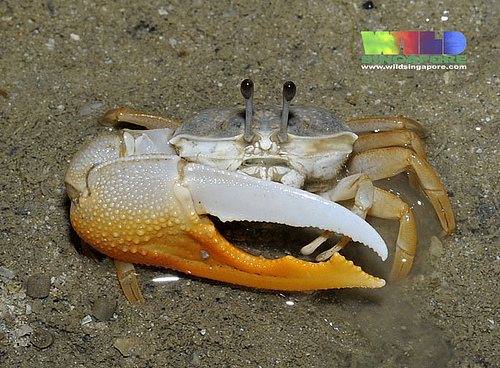
INTRODUCTION
Table of Contents
Interestingly, only male fiddler crabs have an enlarged major claw, which some also perceive to be one of the most striking morphological asymmetries in the animal kingdom [1]! Can you believe that this enlarged claw alone constitutes one-third, or even half, of its total body weight [1]? The orange fiddler crab is also rather unique because more than 95% of its males are right-handed, whereas in most fiddler crab species, this enlarged claw occurs equally often on the left and right [2].
How does this enlarged claw affect the male's daily activities? And are there any other differences between the orange fiddler crab male and female? Read on to find out more about this interesting crab!
BIOLOGY AND BEHAVIOUR
Waving
Waving displays are an important part of social interactions among fiddler crabs, such as to attract mates or to intimidate competitors for food or mates [3]. In the case of the orange fiddler crab, waving displays are simple vertical movements [1]. Some of us might suspect waving is an act exclusive to males to show off their enlarged claw. You would be surprised to know that females have waving displays too [3]! In fact, female waving has been observed to be relatively similar to male waving [4].In the video below, you will observe that the duration of each wave is about 1s to 2s, and the slow upward stroke is followed by a rapid downward stroke [1]. It raises its claw such that the upper edge of its dactyl reaches at most slightly above the tip of its eye [1]. Watch as this male crab waves both when it is stationary and while it is walking [1]!
Diet and Feeding
The orange fiddler crab is a surface deposit feeder. It processes the sediment and extracts detritus, algae and bacteria using its mouthparts, and then discards unwanted material as sand pellets [5]. When feeding, this crab uses its feeding claws to scoop up substrate and transfer it to its mouth [5]. While the enlarged claw on males may look impressive, it is not functional in picking up food [5]! While males have only one functional feeding claw, females have two small feeding claws, so they feed more efficiently than males [3].The orange fiddler crab is one of the few fiddler crab species to form droves. This means, during the low tide period, they move as a group in apparent formation from the upper beach to the low-tide levels [1], where food supply is often abundant [6]. Males have been seen migrating up to 10m away from their burrows [7]! Such formation of droves is more likely when their burrows are in locations that are poor in organic matter, namely higher zones or relatively sandy habitats [6]. This is an adaptive behaviour to increase their feeding efficiency [6].
Interestingly, the orange fiddler crab females have been observed to frequently scoop up small amounts of material and carry it into their burrows during low tide. During high tide, they can continue feeding underground [8]. However, this behaviour is less common among orange fiddler crab males [3].
Mating
The orange fiddler crab males have three key mating strategies, which are used under different circumstances [3].| (a) Standard gambit This is the most common mating strategy among the orange fiddler crabs. Males would approach a female at her burrow entrance, and proceed to stroke her side or the dorsal surface of her carapace using their walking legs and small claw. |
(b) Herding Among all mating strategies, waving features most prominently in herding. This strategy is mainly used by males on females wandering through the colony. The male will try to intercept her path and proceeds to wrap his rear walking legs around the female's carapace to force her into his burrow. |
(c) Dig-out Unlike the other two strategies, a dig-out is energetically costly and is usually used as a last resort during the end of the tidal cycle because other mating strategies are no longer possible. Before the incoming tide, most females enter their burrows and seal them. A dig-out involves males reopening their burrows. However, there is always a risk because they cannot tell whether closed burrows belong to a male or a female! If they get it wrong, this may lead to fights with the male inhabitants. |
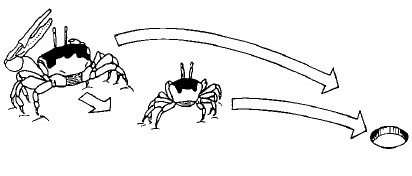 |
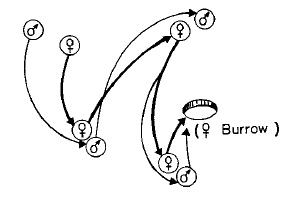 |
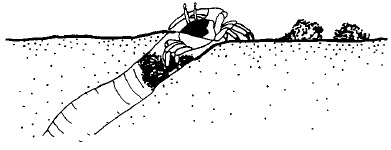 |
| Source: Salmon (1984) [3]. Used with permission from John Wiley and Sons. |
Source: Salmon (1984) [3]. Used with permission from John Wiley and Sons. |
Source: Salmon (1984) [3]. Used with permission from John Wiley and Sons. |
How often do the males succeed in these courting attempts? The orange fiddler crab females are found to be selective, so the males’ courting attempts do not always succeed [3]. How then do the females decide on their mates? Perhaps the size of their claws matter? Surprisingly, the orange fiddler crab females have not been observed to show preference for larger males with larger claws [8]! This is possibly because they do not rely on any resources provided by males, so they do not benefit even if they choose males which can produce larger burrows using their large claws [8]. Instead, the vigour and persistence of male courtship, such as whether they return for second or third rounds of stroking after being rejected by a female the first time, appear to be the deciding factors behind the females’ mate choice [3].
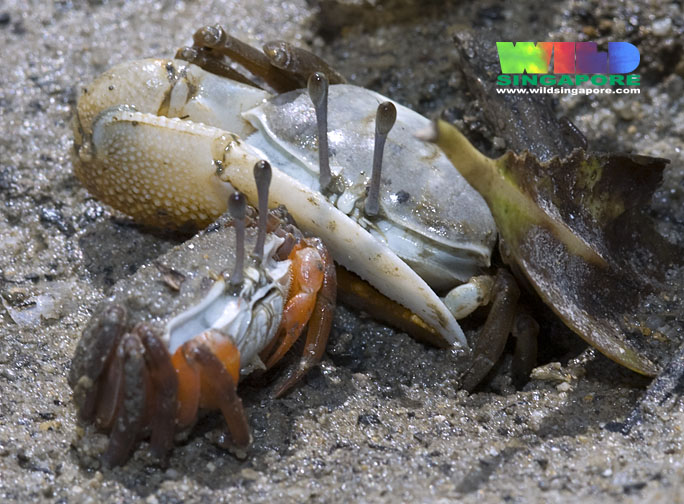 |
| A male and a female orange fiddler crab. Photo by Ria Tan, used with permission. |
Combat
Both sexes tend to be aggressive towards members of the same sex [3]. Male-male fights are short in duration and often occur among males courting the same group of females. Conversely, female-female fights can be long in duration and usually occur while foraging [3].It is interesting to note that the agonistic repertoire of females is comparable to that of males, and even consists of postures unique to their sex [3]! Of course, some movements are also unique to males, especially when they are executed by their enlarged claw [3]. The video below features an intense and exciting fight between two males. Watch as they execute a forceful movement pattern that males commonly display – “grips, flings and upsets” [3]!
Remember one unique feature of this fiddler crab species is its predominant right-handedness? You might wonder, what could it mean for an orange fiddler crab leftie to be stuck in a world of right-handed males? Considering that left-handed males will almost always encounter a right-handed male, they should have more experience than right-handed males in fighting opposite-handed males. Thus, ecologists had previously suspected that left-handed males would have a fighting advantage. However, a study conducted on a closely related species suggests that left-handed males actually initiate fewer fights and when they do, they are also less likely to win [9].
Autonomy and Claw regeneration
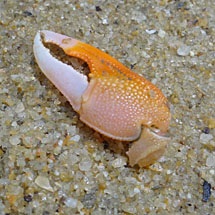 |
| Photo by Ria Tan, used with permission. |
During some intertidal walks, perhaps you will find loose orange claws on the shore. What could have possibly happened? Like many crabs, this fiddler crab is capable of breaking off its claws or legs, an ability also known as autonomy [5]. It is an automatic response which allows it to separate an injured limb from its body [5]. This ability probably comes in especially handy for the orange fiddler crab male because its orange enlarged claw often attracts not only the females, but also its predators [10]! Sometimes, its predator may be surprised to find itself holding on to only its claw while this crab quickly makes its escape. Autonomy may also occur during one of those intense fights against other fiddler crabs [5], which you have just witnessed in the previous video.
Fortunately, the loss of any of its limbs is not permanent. Considering the importance of the enlarged claw to the male crab, this certainly comes as a relief. Instead, a new claw will grow with each additional round of moulting, a process in which the crab sheds its shell [5]. After a few moults, its regenerated claw will be about the same size as its original claw [5]!
Respiratory physiology
Like most crabs, the orange fiddler crab is well-adapted to breathe air [11]. So during high tide, it hides in its burrow and seals the opening to trap air inside the burrow [3]. Its burrow remains inundated except for a short period during low tide [11].To survive prolonged periods of submersion, it also has well-developed gills capable of extracting oxygen from water [11].HABITAT
As mentioned above, the orange fiddler crab hides in its burrow during high tide. But burrows are also important during low tide to provide it refuge from predators and shelter from environmental extremes [1]. They are also sites of reproduction and moulting [1]. Usually associated with muddy to sandy substrate, this crab and its burrow are often found at the fringe of mangroves, in the lower intertidal zones [1].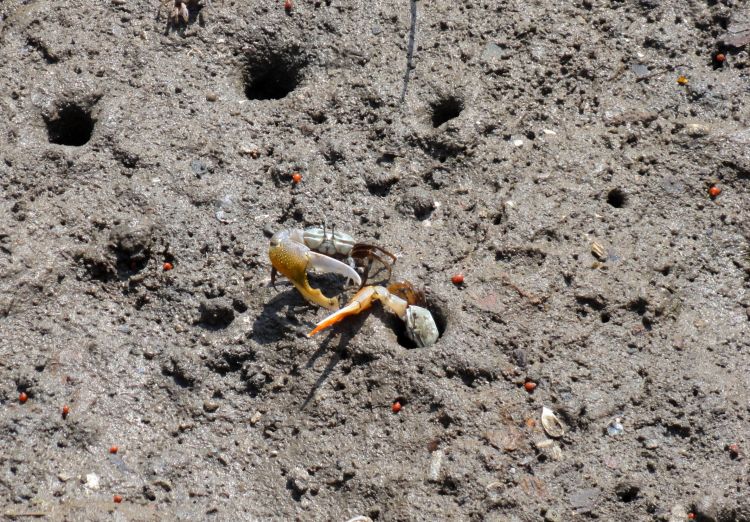 |
| Photo by Veronika Patrovská-Vernerová, used with permission. |
ECOLOGICAL IMPORTANCE
Besides the importance of burrows to the orange fiddler crab, burrowing activities also have several benefits to the ecosystem [12]. Burrows help to improve drainage of the soils, provide an oxygen-rich environment for soil microbes and mangrove roots, and also greatly increase nutrient cycling in the mangrove system [12]. Fiddler crabs are also a rich source of food for birds [13].The orange fiddler crab has not been assessed for the IUCN Red List and does not have an official conservation status. However, this does not imply that it is free from threats. It has been noted that one of the biggest threats fiddler crabs face is habitat loss or human disturbance, such as shoreline development [14]. Given the rapid rate of urbanisation in Singapore, it is important to preserve as many of our remaining natural ecosystems as possible. By conserving fiddler crabs, we are also protecting the continued benefits that it provides to the larger ecosystem.
 |
|
| 2000 SingPost Care-for-Nature Wetland Wildlife Series of postage stamps Source: www.wooliebackcollectables.com Permission pending. |
Mangrove system during a low tide period. Photo by Cheryl Koh. |
MORPHOLOGY
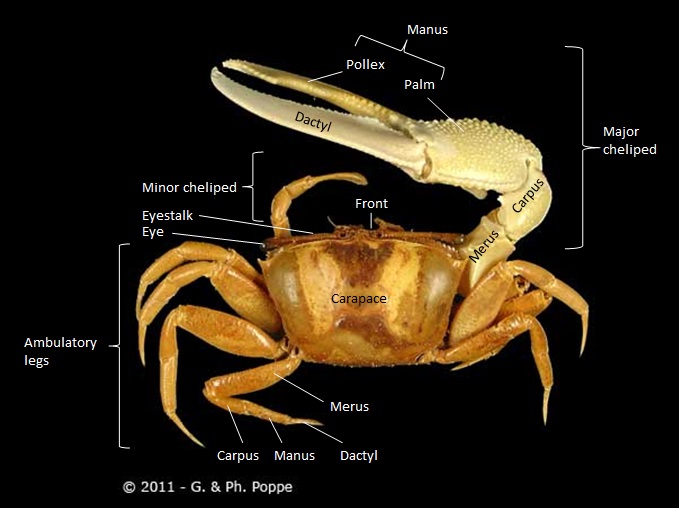
Dorsal view of Uca vocans male, right-handed.Photo by Guido & Philippe Poppe, taken from www.conchology.be and used with permission. Labels by Cheryl Koh.
These are a few notable characteristics which can help in the identification of the orange fiddler crab [1]:
- Strong tubercles on outer margin of major cheliped
- Ridge inside palm high
- Pollex and dactyl of major cheliped flattened
- Merus of all ambulatories slender
Nonetheless, it may still be difficult to identify the orange fiddler crab especially if you are looking at an assemblage of different fiddler crab species. In Singapore, the orange fiddler crab is often found living in close proximity with another common fiddler crab species, Uca annulipes (Porcelain Fiddler Crab) [15]. So there may be a need to look more closely at them to tell these two species apart!
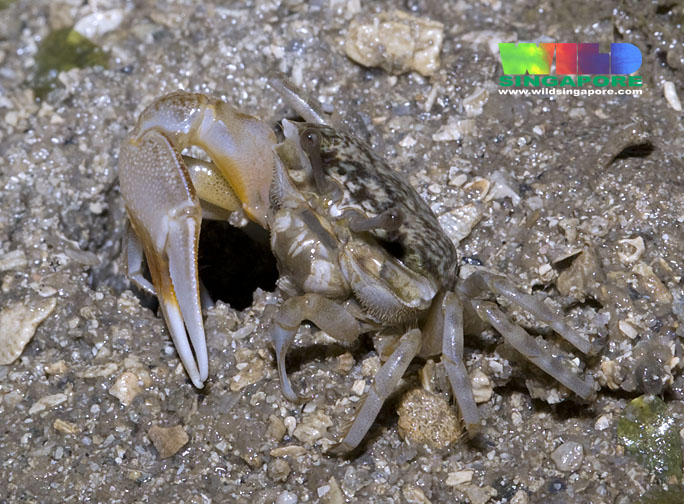 |
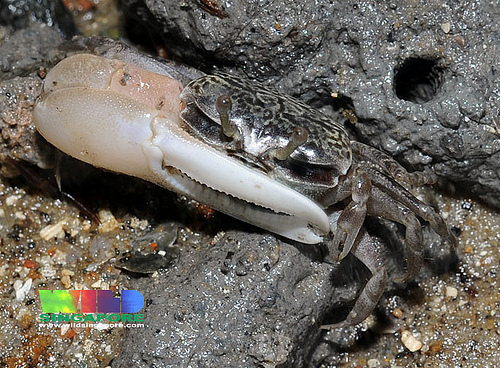 |
| Can you differentiate between these two common fiddler crab species in Singapore? Left: Uca vocans (Orange Fiddler crab). Right: Uca annulipes (Porcelain Fiddler Crab). Photos by Ria Tan, used with permission. |
|
DISTRIBUTION
If you wish to find the orange fiddler crab in Singapore, you may consider visiting Changi beach, Chek Jawa, Kusu Island, Pasir Ris Beach, Pulau Hantu, Pulau Semakau, or St John’s Island. You just might catch them in action during low-tide periods!This fiddler crab can also be found beyond Singapore’s shores. It is widely distributed in the tropical western and Indo-Pacific region [1].
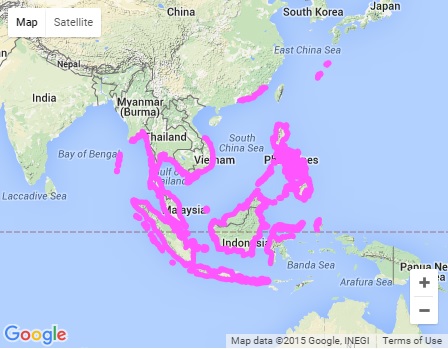
Global distribution of Uca vocans. Source: Rosenberg (2015),taken from www.fiddlercrab.info, used with permission.
TAXONOMY
Original description
The orange fiddler crab, Uca vocans, was first described by Linnaeus as Cancer vocans in 1758 [16].As seen in the image below, the original description by Linnaeus was written in Latin. Did you know that Cancer is Latin for “crab”? And more interestingly, did you know that vocans is Latin for “calling”, or “gesturing” [17]? Considering its conspicuous waving behaviour, it is probably not surprising that it was called a “calling crab” or “gesturing crab”!
 |
| Original description of Cancer vocans by Linnaeus in 1758 [16]. Source: Biodiversity Heritage Library. |
Since this fiddler crab was first described as Cancer vocans, perhaps the first question that comes to mind now is, how did it end up being known as Uca vocans today?
Cancer vocans to Gelasimus vocans
Originally, Linnaeus had placed all crab species, including Cancer vocans, in the single genus Cancer (Latin for “crab”). As people studied crabs more closely, they realised that there were several subtypes. To distinguish them, they started to create more genera and moved some of the more unique crab species out of Cancer into their new genera. Cancer vocans was one of these species perceived to be rather different. At various points in its history, it was shifted to a number of different genera. The key development to note, however, is that in 1817, Latreille created the genus Gelasimus and moved Cancer vocans into this new genus, such that it became known as Gelasimus vocans [18].
Gelasimus vocans to Uca vocans
However, prior to Latrielle's introduction of the genus Gelasimus, the genus Uca was created by Leach in 1814 [19] and both names Gelasimus and Uca were given based on the same drawing of a fiddler crab by Seba (1758) [20]. In 1897, Rathbun showed that the abandonment of the older name Uca and the subsequent use of Gelasimus violated zoological naming conventions, and he officially synonymised Gelasimus with Uca [21]. (If you are interested, more information behind the reason for synonymising Gelasimus with Uca can also be found here.) Hence, all species in Gelasimus, including Gelasimus vocans, were then shifted to the older genus Uca because it had priority over Gelasimus. This gives rise to the name Uca vocans, which we use today.
You may wish to note that, while Gelasimus is no longer a valid genus, it is used as a subgenus today.
Type location
The original description of Uca vocans by Linnaeus in 1758 as Cancer vocans was made based on a specimen (description and illustration) provided by Rumphius (1705) [22]. However, this specimen, also known as a type, is not extant. Instead, a neotype, Uca vocans vocans has been designated. This neotype was collected in Madaum, Mindanao, Philippines by Crane, and is currently stored in the Smithsonian Institution, National Museum of Natural History, Washington. This neotype consists of one male, filed under the catalogue number 137673 [1].Classification
Kingdom: AnimaliaPhylum: Arthropoda
Subphylum: Crustacea
Class: Malacostraca
Order: Decapoda
Family: Ocypodidae
Genus: Uca
Subgenus: Gelasimus
Species: Uca vocans
Synonyms
Cancer vocans Linnaeus, 1758Gelasimus cultrimanus White, 1847
Gelasimus marionis Desmarest, 1823
Gelasimus vocans (Linnaeus, 1758)
Uca cultrimana (White, 1847)
Uca marionis (Desmarest, 1823) [23]
PHYLOGENY
Apart from looking at Uca vocans in isolation, we may also be interested in learning about how it is related to other species of fiddler crabs through a reconstruction of phylogenetic relationships. This can be done by comparing a suite of characteristics among different fiddler crab species, which are often morphological or molecular information.
Morphological information
Examples of morphological information used to compare different fiddler crab species are the broadness of the front, the general shape of the carapace from a dorsal view, the thickness of the eyestalk, the presence of setae on different segments of their ambulatory legs and whether the gonopod tip is calcified [24]. Of course, this list is by no means exhaustive. In fact, Rosenberg (2001) conducted an extensive comparison of 88 fiddler crab species using a matrix of 236 discrete morphological characters [24]!
It is interesting to note that the major claw is very commonly used for comparison. The handedness of the male crab (the side where the major claw is found on) has been proposed as useful evidence for the reconstruction of phylogenetic relationships [25]. The differences in the structure of the major claw also provide substantial evidence. Some examples of structural differences in the claw are the presence of tubercles on the outer claw, the presence of a stridulating ridge at the base of the major claw and the length of the pollex relative to the manus [26]. Although there is also variation in the shape and structure of the minor claw, it has been less studied compared to that of the major claw [24].
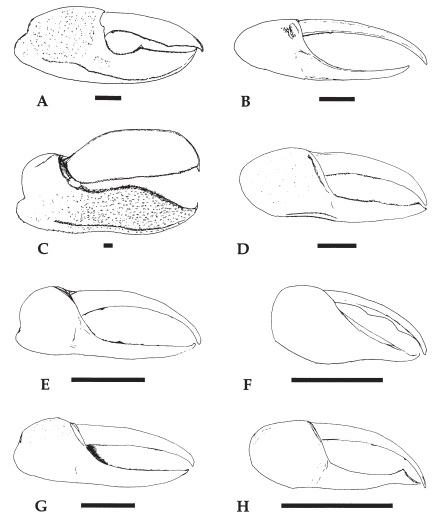 |
| Examples of major claw morphology variation in eight different fiddler crab species in Uca. Each illustration is of the outer surface of a right major claw. The bar under each claw represents 5mm. Source: Rosenberg (2002) [26]. Used with permission from John Wiley and Sons. |
Molecular information
With the advancement of molecular techniques in recent years, it is increasingly common to use molecular information to reconstruct phylogenetic relationships. Molecular data can be used to complement morphological data.
An analysis on fiddler crabs that combined morphological and molecular data was recently conducted by Shih (2015) [27].
Specimens of different fiddler crab species were obtained and examined for a few morphological characteristics, namely the carapace, major cheliped, gastric mill, male first gonopod, and chela handedness. Sequences of three genes, namely mitochondrial 16S rDNA, mitochondrial cytochrome oxidase subunit I (COI), and nuclear 28S rDNA, were also obtained from the specimens. The best-fitting models for sequence evolution of individual datasets were selected by the Akaike information criterion (AIC). Based on AIC values, the best models for the three individual datasets were all GTR + G + I. These models were subsequently used for the partitioned Bayesian inference (BI) and maximum likelihood (ML) analyses. The ML trees were also assessed for the stability of their nodes using the bootstrap method.
The resultant phylogenetic tree suggested that Uca vocans, along with Uca borealis, Uca jocelynae and Uca tetragonon are closely related, and they form the subgenus Gelasimus, a monophyletic group. The monophyly of Gelasimus was maximally supported by both BI and ML analyses (BI 100%, ML 100%).
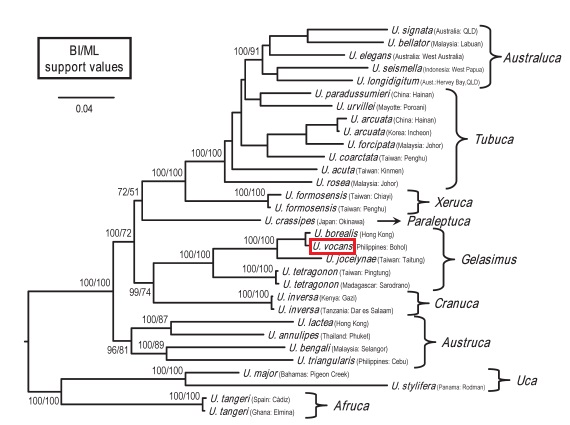 |
| Phylogenetic tree based on 16S, COI and 28S sequences inferred by BI and ML analyses. Values near the nodes of branches represent the posterior probability value of the BI analysis and the bootstrap value for the ML analysis, respectively. Source: Shih (2015) [27]. Used with permission from Zootaxa. |
EXTERNAL LINKS
For more information, please visit:http://www.wildsingapore.com/wildfacts/crustacea/crab/ocypodoidea/vocans.htm
http://species-identification.org/species.php?species_group=crabs_of_japan&id=1769
http://www.fiddlercrab.info/u_vocans.html
Read what others have to say about their personal encounter with the orange fiddler crab on our Singapore shores!
http://makingmum.blogspot.sg/2014/08/wild-wednesdays-hunting-for-fiddler.html
http://lazy-lizard-tales.blogspot.sg/2009/06/pasir-ris-beach-is-medley-of-colours.html
REFERENCES
[1] Crane, J., 1975. Fiddler crabs of the world (Ocypodidae: genus Uca). Princeton University Press, Princeton, New Jersey. 736 pp.[2] Williams, M. T. & K. H. Poon, 1981. Handedness in males of Uca vocans (Linnaeus, 1758) (Decapoda, Ocypodidae). Crustaceana, 40(2): 215-216.
[3] Salmon, M., 1984. The courtship, aggression and mating system of a “primitive” fiddler crab (Uca vocans: Ocypodidae). The Transactions of the Zoological Society of London, 37(1): 1-50.
[4] Zann, M., 2008. The spatial distribution and socioecological factors influencing spacing in five ocypodid crab species (Decapoda: Brachyura) on the eastern Australian coast. Unpublished Honors Thesis, University of Queensland, Brisbane.
[5] Weis, J. S., 2012. Walking Sideways: The remarkable world of crabs. Comstock Publishing Associates, New York, Ithaca. 239 pp.
[6] Murai, M., S. Goshima & Y. Nakasone, 1983. Adaptive droving behavior observed in the fiddler crab Uca vocans vocans. Marine Biology, 76(2): 159-164.
[7] Nakasone, Y., 1982. Ecology of the fiddler crab Uca (Thalassuca) vocans vocans (Linnaeus) (Decapoda: Ocypodidae) I. Daily activity in warm and cold seasons. Researches on Population Ecology, 24(1): 97-109.
[8] Christy, J. H. & M. Salmon, 1984. Ecology and evolution of mating system of fiddler crabs (Genus Uca). Biological Reviews, 59(4): 483-509.
[9] Backwell P. R. Y., M. Matsumasa, M. Double, A. Roberts, M. Murai, J. S Keogh, M. D Jennions, 2007. What are the consequences of being left-clawed in a predominantly right-clawed fiddler crab? Proceedings of The Royal Society B, 274(1626): 2723-2729.
[10] Jordão, J. M., & R. F. Oliveira., 2001. Major claws make male fiddler crabs more conspicuous to visual predators: a test using human observers. Hydrobiologia, 449(1): 241-247.
[11] Jimenez, A. G. & W. A. Bennett, 2005. Respiratory physiology of three Indo-Pacific fiddler crabs: metabolic responses to intertidal zonation patterns. Crustaceana, 78(8): 965-974.
[12] Kristensen, E. & D. M. Alongi, 2006. Control by fiddler crabs (Uca vocans) and plant roots (Avicennia marina) on carbon, iron, and sulfur biogeochemistry in mangrove sediment.Limnology and Oceanography, 51(4): 1557-1571.
[13] Zeil, J., J. M. Hemmi & P. R. Y. Blackwell, 2006. Fiddler crabs. Current Biology, 16(2): R40-R41.
[14] "Fiddler crabs", by Behera, S. B. ENVIS newsletter, Nov 2008. URL: http://www.cesorissa.org/PDF/Newsletter15.pdf (accessed on 11 Nov 2015).
[15] Lim, S. L. L., P. S. Lee, C. H. Diong, 2005. Influence of biotope characteristics on the distribution of Uca annulipes (H.Milne Edwards, 1837) and U.vocans (Linnaeus, 1758) (Crustacea: Brachyura: Ocypodidae) on Pulau Hantu Besar, Singapore. The Raffles Bulletin of Zoology, 53(1): 111-114.
[16] Linnaeus, C.,1758. Systema Naturæ. 10th Edition, Volume I.
[17] "Common names of fiddler crabs", by Rosenberg. Fiddler Crabs. URL: http://www.fiddlercrab.info/uca_common_names.html (accessed on 25 Nov 2015).
[18] Latreille, P.A.,1817. Gélasime, Gelasimus (Buffon) in Nouveau dictionnaire d'histoire naturelle, appliquée aux arts, à l'Agriculture, à l'économie rurale et domestique, à l'médecine, etc. Par une société de naturalistes et d'agriculteurs, Volume XII. Paris: Deterville. Pp. 517-520.
[19] Leach, W.E., 1814. Crustaceology in The Edinburgh Encyclopædia, D. Brewster, ed., Volume 7. Edinburgh: William Blackwood. Pp. 383-437.
[20] Seba, A., 1758. Locupletissimi Rerum Naturalium Thesauri Accurata Descriptio et Iconibus Artificiosissimis Expressio per Universam Physices Historiam, Volume 3 Amsterdam: Janssonio-Waesbergios. {Cabinet of Natural Curiosities}
[21] Rathbun, M. J., 1897. A revision of the nomenclature of the Brachyura. Proceedings of the Biological Society of Washington, 11: 153–167.
[22] Rumphius, G.E. (1705) D'Amboinsche rariteitkamer, behelzende eene beschryvinge van allerhande zoo weeke als harde schaalvisschen, te weeten raare krabben, kreeften, en diergelyke Zeedieren, als mede allerhande hoorntjes en schulpen, die men in d'Amboinsche Zee vindt: Daar beneven zommige mineraalen, gesteenten, en soorten van aarde, die in d'Amboinsche, en zommige omleggende Eilanden gevonden worden Amsterdam: François Halma.
[23] "Uca vocans", by Rosenberg. Fiddler Crabs. URL: http://www.fiddlercrab.info/u_vocans.html (accessed on 25 Nov 2015)
[24] Rosenberg, M. S., 2001. The systematics and taxonomy of fiddler crabs: a phylogeny of the genus Uca. Journal of Crustacean Biology, 21(3): 839-869.
Rosenberg, M. S., 2002.
[25] Jones, D. S., & R. W. George, 1982. Handedness in fiddler crabs as an aid in taxonomic grouping of the genus Uca (Decapoda, Ocypodidae). Crustaceana, 43(1): 100-102.
[26] Fiddler crab claw shape variation: a geometric morphometric analysis across the genus Uca (Crustacea: Brachyura: Ocypodidae). Biological Journal of the Linnean Society, 75(2): 147-162.
[27] Shih, H., 2015.Uca (Xeruca), a new subgenus for the Taiwanese fiddler crab Uca formosensis Rathbun, 1921 (Crustacea: Decapoda: Ocypodidae), based on morphological and molecular evidence. Zootaxa 3974(2): 151-169.
[Back to Top]